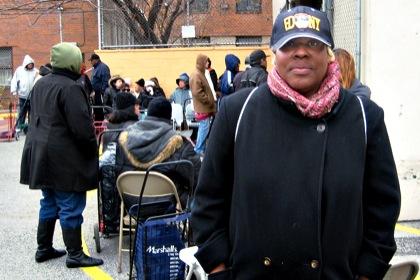By Jeremy Walsh
A simple note is posted in thick permanent marker on the door of the Hour Children food pantry in Long Island City: “I’m very sorry, but we have no turkeys or chickens this year. We will try to make it a good pantry though.”
The note was written by Christy Robb, the pantry’s executive director, who said her budget has been stretched to the breaking point by increased demand.
“I’ve been working in food pantries for 22 years,” she said. “I’ve never had a Thanksgiving where I didn’t have a bird to give out.”
Such are the conditions at the pantry, which has experienced a 33 percent increase in clients over the past year. Like many facilities that serve the hungry in Queens, they are struggling to feed the needy, even as the percentage of agencies citywide unable to meet demand decreased from 2008 figures.
Some 60.4 percent of the Queens pantries that responded to the survey this year did not have enough food to meet the growing demand, compared with 76.8 percent in 2008.
But those numbers are small consolation to organizations like Hour Children, which serves the Queensbridge, Ravenswood and Astoria houses, projects that house a large number of the city’s poor.
Robb said the pantry serves as many as 160 families a week and has had to resort to rationing tactics, like forcing clients to choose between milk and juice and to take two protein items instead of three.
“Meat is very rare now,” said Astoria resident Charles Fitzsimmons, 57, who has been making weekly trips to the pantry since he went on disability from his job as a warehouse supervisor two years ago. “We used to get hamburgers and chicken. Now it’s all dry and canned stuff.”
The Forest Hills-based Queens Jewish Community Council has seen a 30 percent spike in the number of people seeking its help, which includes going to the group’s food pantry, said QJCC Executive Director Cynthia Zalisky. The group had about 10,000 clients last year and Zalisky expects that number to be around 13,000 this year.
“We clean out our pantry in 2 1/2 weeks instead of the four weeks it was a year and a half ago,” she said, echoing other agencies which said that more middle-class families are seeking help. “They keep coming and coming from all walks of life.”
In Queens, 93.4 percent of responding agencies said the number of people they served had increased over the past 12 months. The fastest-growing segment of this population, 45.5 percent, were families with children, followed by senior citizens at 30.4 percent.
“Many people are telling us they lost their jobs. Some do not make enough money to buy food because of their high rents/medical bills,” Griselle Torres, the program coordinator for the Evangelical Church Christ is the Light in Corona, wrote in response to the survey. “They just do not make enough to supply all their needs. And we do not have enough food to put in the grocery bags for 350-400 people a week.”
Nearly half of the agencies in Queens — 48.7 percent — reported receiving less government food and money than last year. Some 15.4 percent reported no change in government support.
The Coalition Against Hunger was enthusiastic about federal anti-hunger spending through the economic recovery bill and increases in the Food Stamp Program in New York City, which amounted to roughly $500 million this year.
“The situation is far less catastrophic than it would have been had the president and Congress not increased anti-hunger funding in the recovery bill and not protected the Food Stamp Program as an entitlement that expands when times are rough,” said Coalition Director Joel Berg in a prepared statement.
But the shortcomings of food stamps were the reason Fitzsimmons cited for waiting in line at Hour Children each Monday.
“With the little pittance of food stamps I get? Ten minutes in the store doesn’t last me a week,” he said.
The Hunger Action Network of New York State, a coalition of hunger groups in the state, worried that further cuts might be on the way to crucial areas like school lunch programs that would further affect children and families living on the edge of poverty as the state Legislature works to cut a multibillion-dollar budget deficit.
“We cannot be in a state that leaves its children behind for the foreseeable future,” said Jennifer March, executive director of the Citizens’ Committee for Children.
Anna Gustafson contributed to this article.
Reach reporter Jeremy Walsh by e-mail at jewalsh@cnglocal.com or by phone at 718-229-0300, Ext. 154.


































